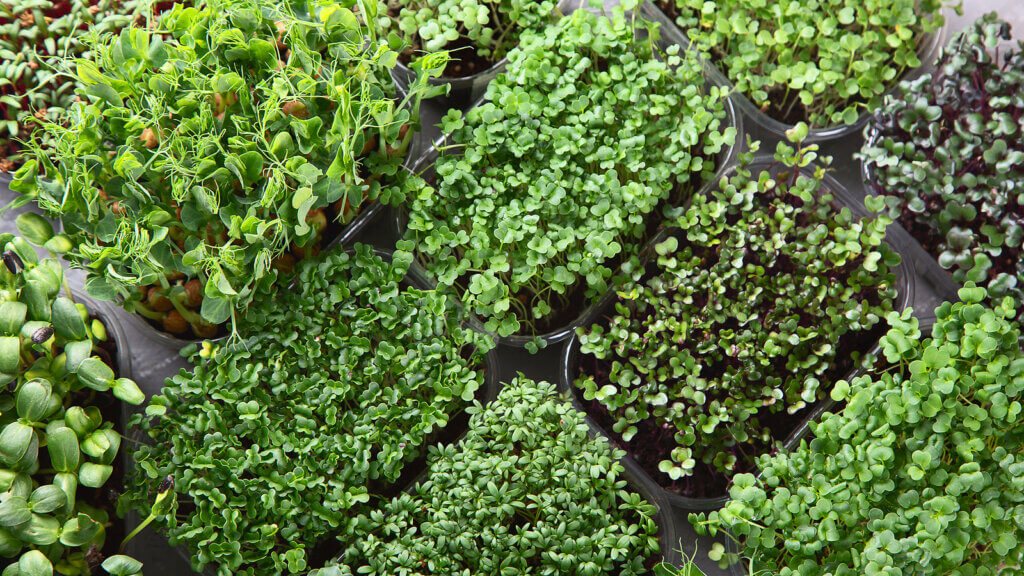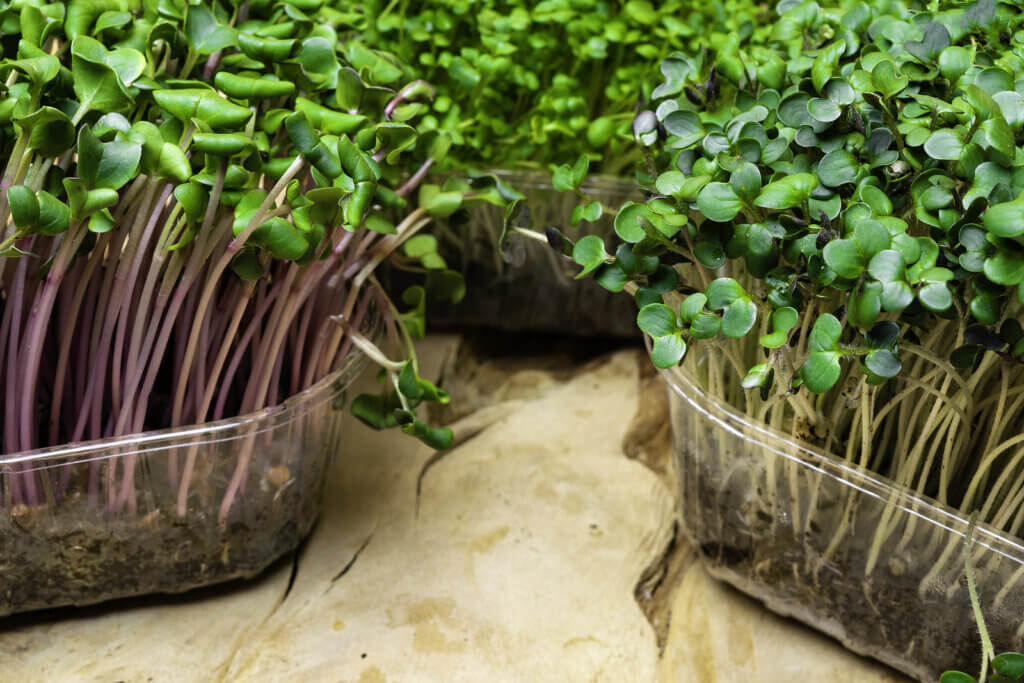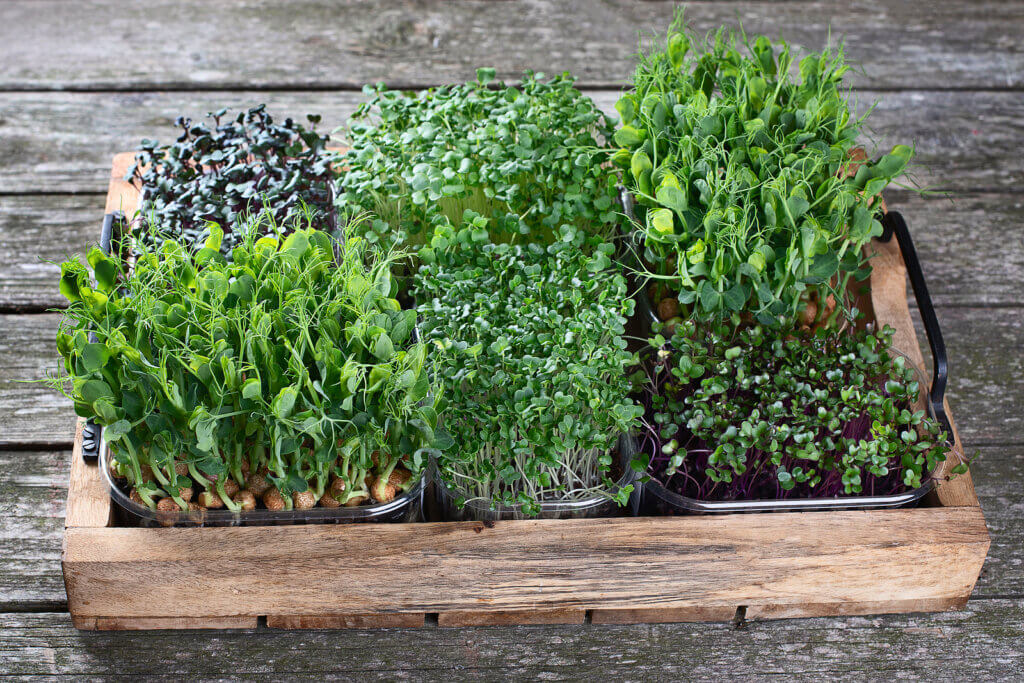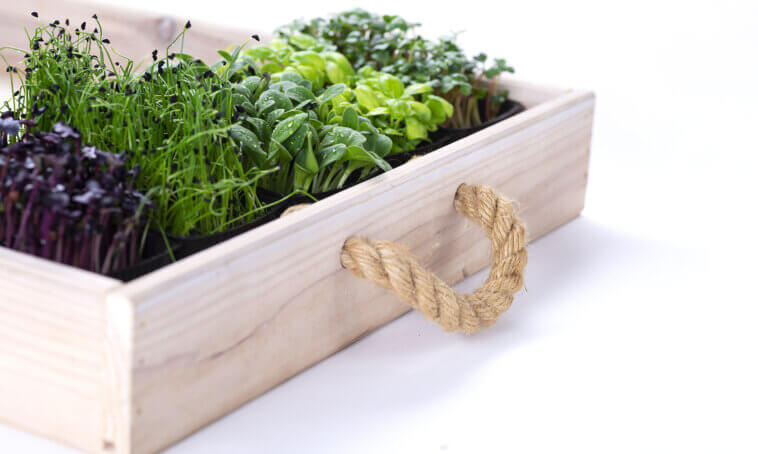Table of Contents
Guide to Mixed Microgreens
Over the past few years, I've developed a keen interest in the world of nutrition and maintaining a healthy diet. One trend that has particularly fascinated me is the rise of mixed microgreens. These little greens may be small, but they are brimming with nutritional goodness.
In this all-encompassing guide, I want to take you on a journey into the realm of mixed microgreens, sharing insights into their origins, the incredible health perks they offer, creative ways to incorporate them into your cooking, and even tips on how to cultivate them right in your own home.
The Origins of Mixed Microgreens
Microgreens: A Brief Introduction
Microgreens, those petite and vibrant greens adorning modern culinary dishes, have an equally fascinating backstory. These tiny marvels represent the tender, young seedlings of various vegetables and herbs.
The magic begins when these seeds germinate and start to grow, and they are ready for harvest in a remarkably short time frame, typically between 7 to 21 days. When they reach a mere few inches in height, microgreens are plucked, unleashing a visual and culinary delight.
A Kaleidoscope of Colors, Shapes, and Flavors
One of the most enchanting aspects of microgreens is their astonishing diversity. They don't just offer a wide spectrum of colors, from deep greens to vibrant reds and purples, but also come in an array of shapes, ranging from delicate, wispy tendrils to robust, broad leaves.
Beyond their visual appeal, microgreens pack a punch in the flavor department as well. Each variety brings its own unique taste profile to the table, from peppery arugula to the zesty kick of radish. This multifaceted nature of microgreens not only adds culinary intrigue but also contributes to their nutritional value.
Mixed Microgreens vs. Single Varieties: The Culinary Showdown
While single varieties of microgreens like arugula or radish microgreens certainly have their merits, mixed microgreens add an extra layer of excitement to the culinary landscape. Mixed microgreens are precisely what their name suggests—a blend of different microgreen varieties thoughtfully combined to create a stunning tapestry of colors, shapes, and flavors.
In a single serving of mixed microgreens, you can expect a symphony of taste sensations, with each microgreen variety contributing its unique character to the ensemble.
The result? A visually captivating and palate-pleasing mix that can transform any dish into a work of art. Whether you're a chef seeking to elevate your creations or a home cook looking to impress, mixed microgreens offer a delightful fusion of flavors and textures that are hard to resist.

Nutritional Powerhouses: The Abundance of Nutrients in Mixed Microgreens
Mixed microgreens are a true nutritional powerhouse, offering a plethora of essential vitamins and minerals that contribute to overall health. These vibrant greens are packed with a wide array of nutrients that make them a valuable addition to any diet.
Rich in Vitamins and Minerals
When you incorporate mixed microgreens into your meals, you're gaining access to a wealth of vitamins and minerals that are crucial for your well-being. Among the standout nutrients found in these tiny greens are vitamin C, known for its immune-boosting properties, vitamin K, which supports bone health and blood clotting, vitamin A, essential for vision and skin health, and various B vitamins that play a role in energy metabolism.
Additionally, mixed microgreens provide an array of essential minerals, including calcium for strong bones, iron for oxygen transport in the body, potassium for maintaining proper heart function, and magnesium for muscle and nerve function.
Antioxidant-Rich Delights
The vibrant and diverse colors of mixed microgreens are not just visually appealing; they are indicative of the presence of powerful antioxidants like carotenoids and polyphenols. These antioxidants help protect your cells from the damaging effects of free radicals, reducing the risk of chronic diseases such as heart disease, cancer, and diabetes. By including mixed microgreens in your diet, you're taking a proactive step towards bolstering your body's defense mechanisms.
Fiber Content for Digestive Health
Mixed microgreens are an excellent source of dietary fiber, a critical component for a healthy digestive system. Fiber aids in promoting regular bowel movements, preventing constipation, and supporting the growth of beneficial gut bacteria.
Furthermore, a diet rich in fiber has been associated with maintaining a healthy weight and reducing the risk of conditions like obesity and type 2 diabetes. Incorporating mixed microgreens into your meals is an easy way to boost your fiber intake and support optimal digestive function.
Low in Calories, High in Nutrient Density
For those who are conscious of their calorie intake, mixed microgreens are an ideal food choice. These greens are remarkably low in calories, making them a guilt-free option for those looking to manage their weight. Despite their minimal calorie content, mixed microgreens deliver a substantial dose of essential nutrients, ensuring that you receive the vitamins and minerals your body needs without the excess calories.

Health Benefits Found in Mixed Microgreens
Mixed microgreens are a nutritional powerhouse that offers an impressive range of health benefits, making them a must-have addition to your daily diet. Beyond their vibrant colors and delicious flavors, these tiny greens pack a punch when it comes to enhancing your well-being.
- Improved Digestion: One of the standout features of mixed microgreens is their abundant fiber content, which plays a crucial role in promoting healthy digestion. Fiber prevents constipation, ensures regular bowel movements, and supports the growth of beneficial gut bacteria. By incorporating mixed microgreens into your meals, you're taking a proactive step towards maintaining optimal digestive health.
- Enhanced Immunity: Mixed microgreens are an excellent source of vitamin C, a potent immune-boosting nutrient. A robust immune system is your body's first line of defense against infections and illnesses. By regularly consuming mixed microgreens, you can bolster your immune system and increase your resilience to various pathogens.
- Anti-Inflammatory Properties: The antioxidants found in mixed microgreens are champions in the fight against inflammation. Chronic inflammation has been linked to a range of serious health conditions, including heart disease and cancer. By including mixed microgreens in your diet, you can harness the power of these antioxidants to help reduce inflammation and lower your risk of chronic diseases.
- Blood Sugar Regulation: Certain types of mixed microgreens, such as broccoli microgreens, have demonstrated the ability to regulate blood sugar levels. This is particularly valuable for individuals with diabetes or those at risk of developing the condition. The natural compounds in these greens work to stabilize blood sugar, making them a valuable addition to a diabetes-friendly diet.
- Weight Management: If you're looking to manage your weight effectively, mixed microgreens can be your secret weapon. Their combination of low calories and high fiber content can help you feel full and satisfied while consuming fewer calories overall. This makes mixed microgreens an ideal choice for weight management and those aiming to maintain a healthy body weight.
Exploring the Versatility of Mixed Microgreens in Culinary Delights
Mixed microgreens are not only a nutritional powerhouse but also a versatile ingredient that can elevate a wide range of dishes with their unique flavors and vibrant colors. Here's a closer look at their culinary uses and how they can enhance your meals:
Salads
Mixed microgreens are the perfect addition to salads, transforming ordinary greens into a flavor-packed and visually appealing masterpiece. Their diverse textures and tastes add complexity to your salad, making it more exciting and nutritious. Whether tossed with other vegetables or combined with fruits, nuts, and a delicious dressing, mixed microgreens can take your salad game to the next level.
Sandwiches and Wraps
Elevate your sandwiches and wraps by incorporating mixed microgreens. These tiny greens not only provide a satisfying crunch but also infuse your creations with a burst of fresh, natural flavors. Whether you're crafting a classic club sandwich or a veggie wrap, mixed microgreens are the secret ingredient that can make your meal unforgettable.
Garnishes
Enhance the presentation and taste of your dishes by using mixed microgreens as garnishes. They make an exquisite final touch for soups, omelets, pasta dishes, and more. A sprinkle of these delicate greens not only adds a pop of color but also introduces a subtle yet delightful herbal note that elevates the overall dining experience.
Smoothies
Take your morning smoothie to a whole new level of nutrition by incorporating mixed microgreens. These greens can be blended seamlessly into your favorite fruit and vegetable combinations, providing a powerful nutrient boost without compromising taste.
Whether you're a fan of green smoothies or prefer fruity blends, mixed microgreens are an excellent way to sneak in additional vitamins and minerals into your diet.
Culinary Experimentation
Don't limit yourself to traditional uses—get creative with mixed microgreens in your cooking endeavors. Try incorporating them into stir-fries, sushi rolls, or even as a topping for pizza. The possibilities are endless when it comes to exploring the unique flavors and textures these greens bring to your culinary creations.

Growing Mixed Microgreens at Home
Growing mixed microgreens at home is a rewarding and straightforward endeavor that allows you to enjoy a constant supply of fresh, nutrient-packed greens right from your own kitchen. Here's a comprehensive guide that not only lists the necessary supplies but also provides insights into seed selection and the step-by-step growing process.
Supplies You'll Need:
- Containers: Choose containers or trays suitable for microgreen cultivation. These can be shallow trays, seedling flats, or even recycled containers like clamshell salad boxes.
- Potting Mix: Select a high-quality, sterile potting mix or seed-starting mix. This provides the ideal growing medium for your microgreens.
- Seeds: Opt for a diverse assortment of microgreen seeds to create a mixed microgreens blend. Consider varieties such as arugula, basil, radish, kale, and any others that pique your culinary interest.
- Proper Lighting: Adequate lighting is crucial for successful microgreen cultivation. You can use natural sunlight or invest in grow lights if you're growing them indoors. Ensure your microgreens receive 12-16 hours of light daily for optimal growth.
Seed Selection:
When selecting seeds for your mixed microgreens, it's essential to curate a blend that not only offers diverse flavors but also ensures a visually appealing mix. Here are some seed varieties to consider:
- Arugula: Adds a peppery kick and unique texture to your mix.
- Basil: Infuses a delightful herbal aroma and flavor.
- Radish: Provides a mild spiciness and vibrant color.
- Kale: Offers earthy flavors and a hint of bitterness.
- Other Varieties: Feel free to experiment with other microgreen seeds like mustard greens, cilantro, or chard to customize your mix further.
Growing Process:
Now, let's delve into the step-by-step process of planting, caring for, and harvesting mixed microgreens at home:
- Preparation: Fill your chosen containers with the potting mix, ensuring it's evenly distributed and lightly packed.
- Sowing: Sprinkle your selected microgreen seeds evenly across the soil surface. Aim for a dense but not overcrowded arrangement.
- Watering: Gently water the seeds using a fine mist or a watering can with a gentle showerhead attachment. Keep the soil consistently moist, but avoid waterlogging.
- Covering: Cover the containers with a lid or plastic wrap to create a humid environment for germination. Remove the cover once the seeds have sprouted.
- Lighting: Place your containers in a location with plenty of light. If you're growing indoors, use grow lights to ensure they receive adequate illumination.
- Care: Monitor your microgreens' moisture levels and ensure they receive sufficient light. They should be ready for harvest in about 7-21 days, depending on the variety.
- Harvesting: Harvest your mixed microgreens when they reach a height of 1-2 inches. Use scissors or a sharp knife to cut them just above the soil line.
- Enjoy: Incorporate your freshly harvested mixed microgreens into salads, sandwiches, or as garnishes for various dishes. Their vibrant flavors and nutritional benefits will enhance your culinary creations.
Frequently Asked Questions (FAQs) About Mixed Microgreens
Q1: What are mixed microgreens?
A1: Mixed microgreens are a blend of young, edible seedlings from various vegetables and herbs. They are typically harvested when they are a few inches tall, within 7 to 21 days after germination, and offer a combination of flavors and textures in a single serving.
Q2: How do mixed microgreens differ from regular vegetables?
A2: Mixed microgreens are much younger and smaller than mature vegetables, which means they are more nutrient-dense. They are often more flavorful and visually appealing, making them an excellent choice for salads, sandwiches, and garnishes.
Q3: What are the health benefits of mixed microgreens?
A3: Mixed microgreens are rich in vitamins, minerals, antioxidants, and fiber. They can aid in digestion, boost the immune system, reduce inflammation, help regulate blood sugar levels, and support weight management.
Q4: How can I incorporate mixed microgreens into my diet?
A4: You can enjoy mixed microgreens in a variety of ways, such as in salads, sandwiches, wraps, soups, omelets, and smoothies. Their versatility allows you to experiment with different flavors and textures in your favorite dishes.
Q5: Can I grow mixed microgreens at home?
A5: Yes, you can easily grow mixed microgreens at home. You'll need containers, potting mix, microgreen seeds, and proper lighting. Detailed instructions on how to plant, care for, and harvest them can be found in Chapter 5 of this guide.
Q6: Where can I buy mixed microgreen seeds?
A6: You can find mixed microgreen seed blends at local gardening stores, online seed retailers, or even in some grocery stores. Look for varieties that include a diverse mix of flavors and colors.
Q7: Are there any safety concerns with mixed microgreens?
A7: Generally, mixed microgreens are safe to consume. However, it's essential to handle and grow them in clean and hygienic conditions to avoid contamination. Always wash them thoroughly before consumption.
Q8: Are mixed microgreens suitable for people with dietary restrictions?
A8: Mixed microgreens are often a suitable choice for various dietary preferences, including vegetarian and vegan diets. They are also gluten-free and can be enjoyed by individuals with gluten sensitivities.
Q9: Do mixed microgreens have a long shelf life?
A9: Mixed microgreens are best enjoyed fresh, as they tend to wilt and lose their nutritional value over time. It's recommended to store them in the refrigerator and consume them within a few days of harvesting or purchase.
Q10: Can I freeze mixed microgreens for later use?
A10: Freezing mixed microgreens is not recommended, as it can negatively impact their texture and flavor. It's best to use them fresh for optimal taste and nutrition.
Conclusion
In my personal exploration of mixed microgreens, I've uncovered a world of culinary excitement and nutritional excellence. These small, vibrant greens have not only added a splash of color and flavor to my dishes but have also become essential allies in my pursuit of a healthy lifestyle. From their humble beginnings as tender seedlings to their impressive array of health benefits, mixed microgreens have captured my heart.
Cultivating these greens at home has been a truly fulfilling experience, connecting me to the process of growth and nourishment in a unique way. As I snip those fresh leaves and incorporate them into my meals, I'm reminded of the beauty of nature and the joys of culinary creativity. Mixed microgreens have become more than just a trend; they've become a daily source of inspiration and well-being, and I invite everyone to embark on this flavorful journey with me.
Sources
https://mpseeds.eu/introduction-to-microgreens-characteristics-and-distinction




Comments
Loading…